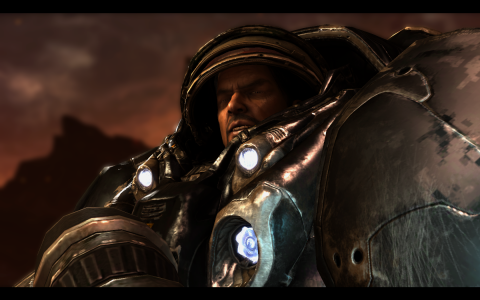
Twelve years is a long time to wait for a sequel, even a sequel to one of the best games ever made. Blizzard itself has poked fun at StarCraft II's long gestation with its frequent refrain of "Hell, it's about time," and while it is in fact about time, it was also completely worth the wait. The Terran-focused Wings of Liberty is so good on all counts that it's going to be really tough to wait for the second and third Zerg- and Protoss-focused chapters of the story, and given Blizzard's penchant for taking its sweet time making games, that might be a long wait. It's a good thing the competitive part of StarCraft II is so great that a lot of players will still be busy battling it out online not just until those follow-ups arrive, but even long after they've come and gone. I know I will be.
While Blizzard has revisited real-time strategy once since 1998 with Warcraft III--and plenty of other developers have refined and evolved the genre in their own ways--the elegant three-way balance of the original StarCraft has remained an institution, so close to perfection that more than a decade later it's still famously practiced as a national pastime in some parts of the world. That's why StarCraft II hews to the same factions and gameplay formula as its vaunted predecessor, and why Blizzard couldn't, and shouldn't, have changed the fundamental core of what this game is. The developers of the new NBA Jam aren't going to add an extra hoop to their sequel just for the sake of making changes. If there's ever another Quake, I'm pretty sure you'll play it in first-person with a gun protruding out of the bottom of the screen. Some games, especially intensely competitive ones, are so brilliantly put-together that their inner workings are basically etched in stone. StarCraft is one of them.
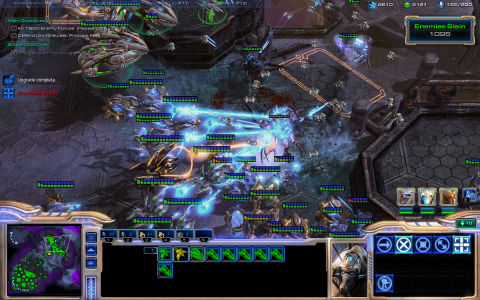
All that is to say that in StarCraft II, you still place unit-producing buildings around a town hall, extract minerals and vespene gas with worker units, and manage multiple production queues simultaneously to win battles. Making more units than the other guy, and using them more deftly than him, remain the two concepts key to achieving victory. That framework is carried over as you remember it from the first game. It's in each race's roster of units and the game's streamlined interface that you'll find the years' worth of improvements you'd expect. There are as many new units as old ones, and even the old ones largely behave in very new ways, and yet that sublime three-way balance is still there. I love the Protoss' giant laser-spewing War of the Worlds walkers the colossi and the Zerg's incredibly annoying flying siege unit the brood lord, and players will be debating the finer points of utilizing these and every other unit in the game for years. There are also plenty of obscure-sounding minor changes to the way the game plays--abilities that now cast unaided, the ability to group production buildings, automation in things like resource-mining--that add up to a major improvement in the way the game plays. StarCraft II is still StarCraft, yes, but modernized in ways that make it feel current and will keep it viable for years to come.
But hold on a second. If you're not some kind of crazed StarCraft grognard who knows what terms like "8 pool" and "natural" mean, all this multiplayer gobbledygook might sound inapplicable (if not downright nonsensical) to you. For you, there's Wings of Liberty's story-driven campaign, which I submit is both accessible and engrossing enough that anyone can enjoy it. It's mostly about the plight of downtrodden hero James Raynor and his ragtag group of rebels, who are still fighting against the human tyrant they unwittingly helped install to power in the first game. Of course, the fallen Terran operative-turned-horrendous Zerg queen Kerrigan gets involved, Raynor's Protoss ally Zeratul shows up with an ancient prophecy, and the next thing you know the fate of creation is in jeopardy. Although this is only the first act of a three-part story, you're left with enough closure to feel satisfied--as well as enough loose ends to make you really wish the next game were already here. The events in Wings of Liberty are momentous enough to completely change the landscape of the series' fiction, and I have no idea how Blizzard intends to continue the story arc. But the storytelling here is good enough that I can't wait to find out.
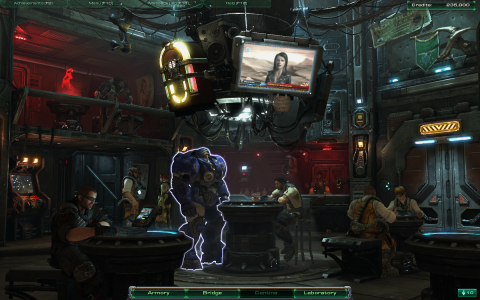
The first StarCraft was split into three short campaigns, each with a handful of missions focusing on one faction, so the outcry was understandable when Blizzard said this game would focus only on the Terrans. But the quality and depth of this campaign bears out that decision; the focus on one faction lets the writers and the designers go far deeper with the characters, the story, and the gameplay mechanics than they ever could have while juggling three factions in one product. In that first game, the objectives rarely got more complex than "destroy the enemy's base to win" or "survive and protect this special unit until the timer runs out," and the story played out only in generic mission briefings, mid-mission voiceover, and infrequent CG cutscenes. In that light, Blizzard has absolutely outdone itself with this game's far longer campaign that contains nearly 30 missions, all of them entirely unique. Every one has individualized, Terran-specific mechanics built into it so you're literally never doing the same thing twice and you're always doing something engaging.
One of them has you attempting to pick up an artifact on a planet being ravaged by a sun that's about to go nova; you're literally fleeing from a wall of fire while you're fighting the enemy, moving your base as you go. Another has you racing to grab minerals faster than a competing faction in order to buy out a mercenary's contract, so she'll help you and not them. (Spending that cash to fight the other faction and slow down your own progress is, of course, a tactical risk.) There's a zombie-style holdout with a day/night cycle where hordes of Zerg-infested humans rush your central position after the sun sets. You rob trains in one mission. I could sit here all day describing unique mission scenarios, but let it suffice that they keep things consistently interesting. It doesn't hurt that there's a shocking number of units and art assets unique to the campaign that you'll never see in multiplayer. It makes the campaign feel shiny and new, all the way through.
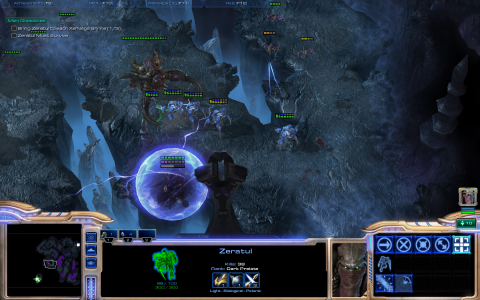
The stuff you do between missions is great, too. You roam around Raynor's ship the Hyperion, chatting with the misfits you've brought to your cause, and I think this is where the focus on a single faction really pays off. There's more here--more depth of character, more believable pathos, more surprise twists--than I honestly expected out of the story. Raynor's a tortured guy, and that comes across in frequent real-time cinematics that are interspersed between each mission. This is the StarCraft universe seen from a close-up view you never got during the breakneck pace of the first game, from barroom fights with Raynor's armored ex-con buddy Tychus to news reports spewing Emperor Mengsk's propaganda. Blizzard's ludicrously detailed CG cinematics also pop up now and again, with one particularly poignant flashback to the events of the first game that really stuck with me (and, curiously, made me wish StarCraft Ghost was still in production). The world that's filled in around the missions feels more fully realized than you'd expect from a real-time strategy game like this. StarCraft may not be the most original piece of fiction ever, but it's sure a lot of fun to watch it play out.
This downtime between missions also gives you the chance to customize your campaign experience, through a huge number of possible persistent upgrades. Every unit you deploy has a couple of specific bonuses you can purchase that makes them tougher or more capable in a fight, and there are also two research trees you fund with Zerg and Protoss samples collected during missions. Every tier of these trees offers two really significant bonuses, but you can only choose one of them, so you're always making tradeoffs that affect how your strategies in subsequent missions will play out. Do you want access to a massive transport that can move your entire army around the map, or a robotic panther with an electrical area of effect attack? Do you want a building that can mind-control any Zerg unit, or another one that dramatically slows down all Zerg units? It's a great way to give you an extra level of control over your strategy, and it makes you feel like you're really building up a rough-and-ready army as you gallivant around the galaxy. That's even reflected in the window dressing as you move through the Hyperion; the neat view of the ship's huge hangar that fills up with new additions to your forces as you acquire them, and gives you a look out the window at the planet you're currently orbiting, is a nice touch.
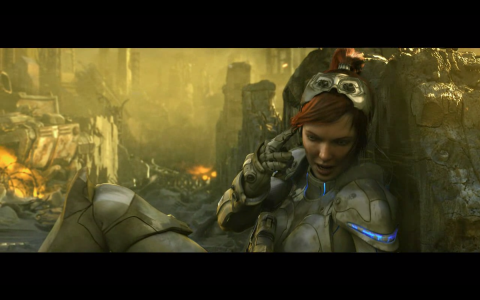
With its wide range of difficulty levels, Wings of Liberty's campaign is accessible to just about anyone. The multiplayer, by its nature, is less so. But the newly redesigned Battle.net service makes a valiant effort to ease new players into what's admittedly a very complex game. There's a really useful series of tough tiered challenge levels that teach you the basics on a per-faction basis, from which units counter which other units to how to micromanage your troops and how to rely on hotkeys to streamline your game. You can play AI opponents on multiple difficulty levels and with friends, to practice and learn before you get online. And once you do, you get 50 unranked matches that don't go on your permanent record in which to practice against other random players. Once you're ready to play for real, there's an elaborate five-tier league system that matches you to players of similar skill, based on your performance in five placement matches.
Depending on how those random matches go, you might place a little too high or too low on the ladder before your subsequent performance equalizes and you settle into the appropriate level. You may lose at first, but that's how you learn. StarCraft II is such an intricate game that the potential for further developing your skills is almost endless, and with a little time the ladder system will put you in the mix with others who are working on a similar skill level. The days of Brood War's Wild West online play are pretty much over. StarCraft II is a sometimes unforgiving but immensely rewarding online experience, and I think the new Battle.net helps make it more the latter than the former.
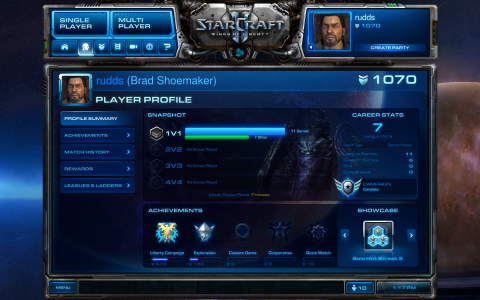
That tiered matchmaking system is the critical piece of the online puzzle, but all the social features wrapped around it are also incredibly well integrated. Your friends list is accessible at any time and you can even pop up little IM-style chat windows with any other player while you're in the middle of a campaign or multiplayer game. (Though, if you're playing multiplayer, what are you doing chatting?) The game has a non-invasive Facebook Connect feature that lets you easily get people you know onto your friends list, and once they're on the list, it's easy to get people into parties and start multiplayer matches. There's a shocking amount of data available through the profile view, showing everything from which of the game's dozens of achievements a player has earned to intensive breakdowns of every online match they've ever played. I'm talking about timecoded build orders, detailed economy graphs, the works--more data than you'd ever want to see, really, unless you're the sort of person who's worried about streamlining your openers or increasing your "actions per minute." But if you are that person, this sort of thing is invaluable. Everything on this new Battle.net is smartly connected and streamlined in the ways you'd expect out of an online service that's contemporary with other excellent platforms like Steam and Xbox Live.
StarCraft II expertly walks the line between remaining faithful to its design legacy and evolving everything about itself that can evolve without fundamentally changing what the game is. I'm so enamored with it that this review is now officially getting in the way of playing more of it, so I'll just say in closing that anyone with even a passing interest in real-time strategy games should absolutely give Wings of Liberty a look. There's a good reason the original StarCraft persisted for over a decade, and its sequel is fully equipped to pick up the torch and carry on for at least as long.